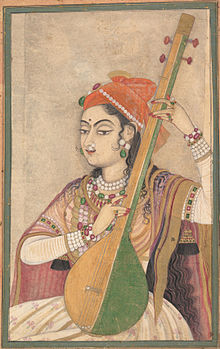Harikathe
| Music of India | |
|---|---|

A Lady Playing the Tanpura, ca. 1735 (Rajasthan)
|
|
| Genres | |
|
|
| Media and performance | |
| Music awards | |
| Music festivals | |
| Music media | |
| Nationalistic and patriotic songs | |
| National anthem | Jana Gana Mana |
| Regional music | |
|
|
Harikatha (Harikathe in Kannada), literally " Stories of Hari(Narayana)", also known as Katha Kaalakshepa ("Katha storytelling" - Spending time with kathe), is a form of Hindu religious discourse in which the storyteller explores a religious theme, usually the life of a saint or a story from an Indian epic.
Harikatha is a composite art form composed of storytelling, poetry, music, drama, dance, and philosophy. Any Hindu religious theme may be the subject for the Harikatha. At its peak Harikatha was a popular medium of entertainment, which helped transmit cultural, educational and religious values to the masses.
The main aim of Hari Katha is to imbue truth and righteousness in the minds of people and sow the seeds of devotion in them. Another of the aims is to educate them about knowledge of self (atman) through stories and show them the path of liberation.
In Hindu mythology, the first Harikatha singer was sage Narada who sang for Vishnu, other prominent singers were Lava and Kusha twin sons of Rama, who sang the Ramayana in his court at Ayodhya.
Telugu Harikatha originated in Coastal Andhra during the 19th century. Harikatha Kalakshepam is most prevalent in Andhra even now along with Burra katha. Haridasus going round villages singing devotional songs is an age-old tradition during Dhanurmaasam preceding Sankranti festival. Ajjada Adibhatla Narayana Dasu was the originator of the Telugu Harikatha tradition, and with his Kavyas and Prabandhas has made it a special art form.
Harikatha involves the narration of a story, intermingled with various songs relating to the story. Usually the narration involves numerous sub-plots and anecdotes, which are used to emphasise various aspects of the main story. The main story teller is usually assisted by one or more co-singers, who elaborate the songs and a Mridangam accompanist. The storyteller uses a pair of cymbals to keep beat.
...
Wikipedia
